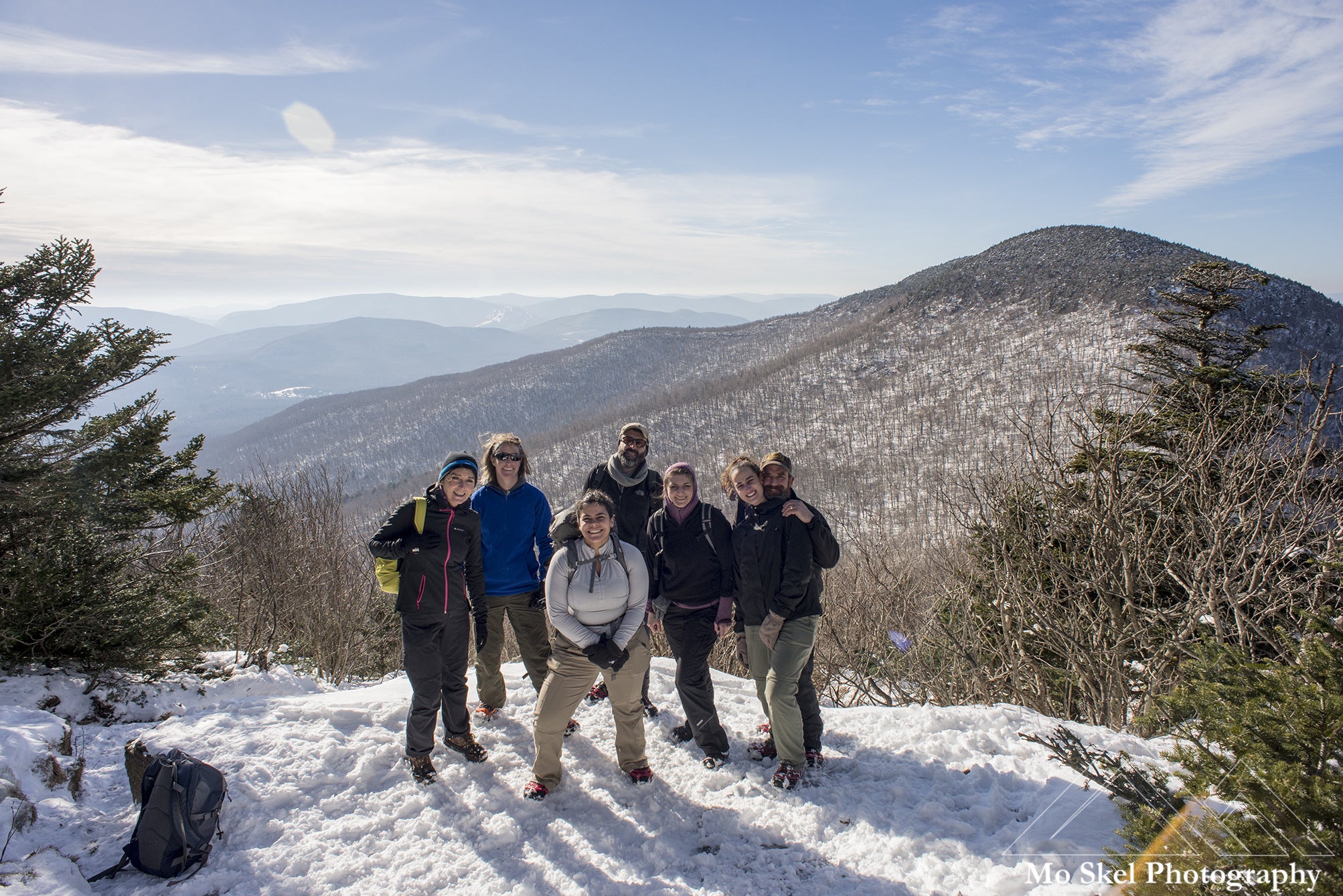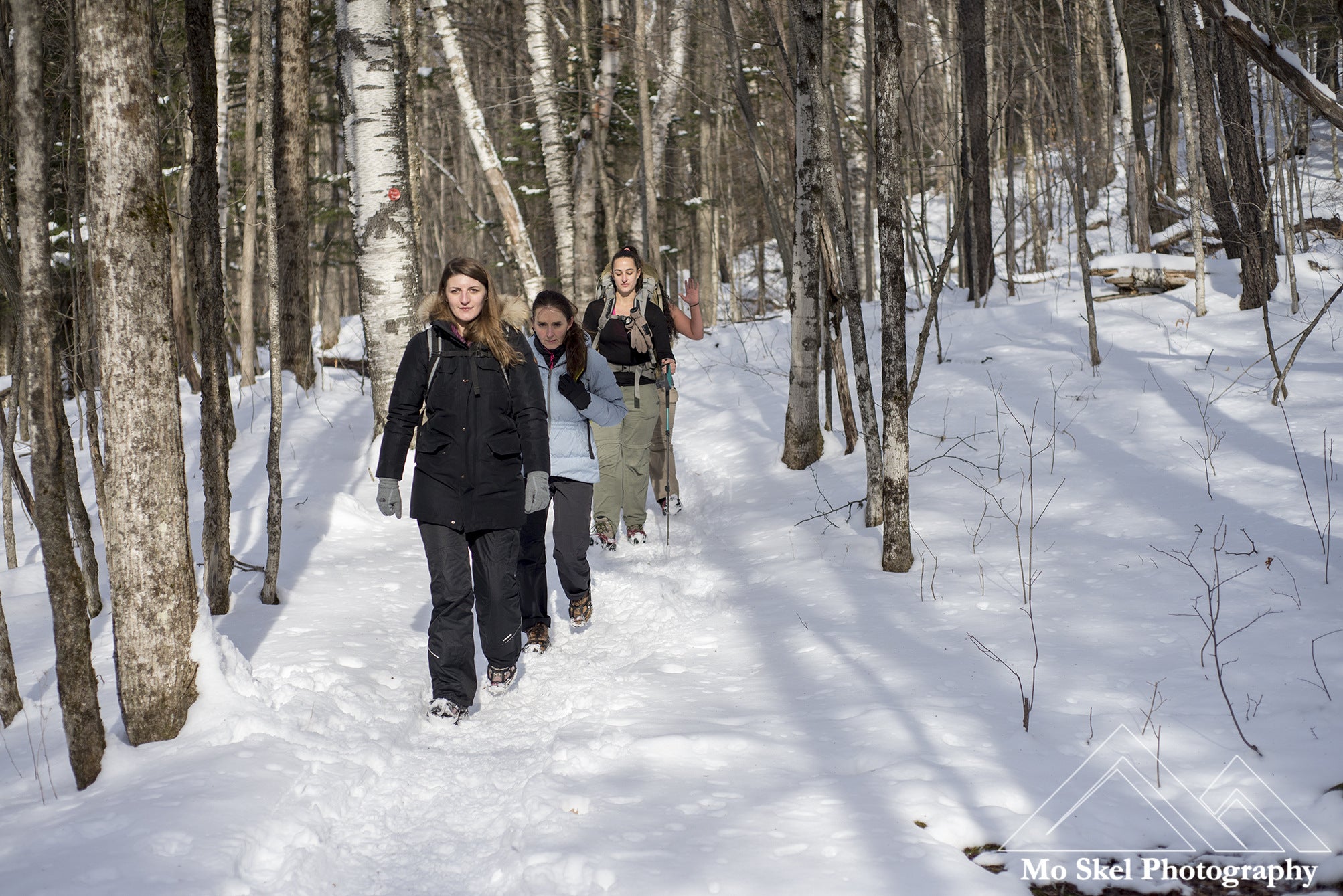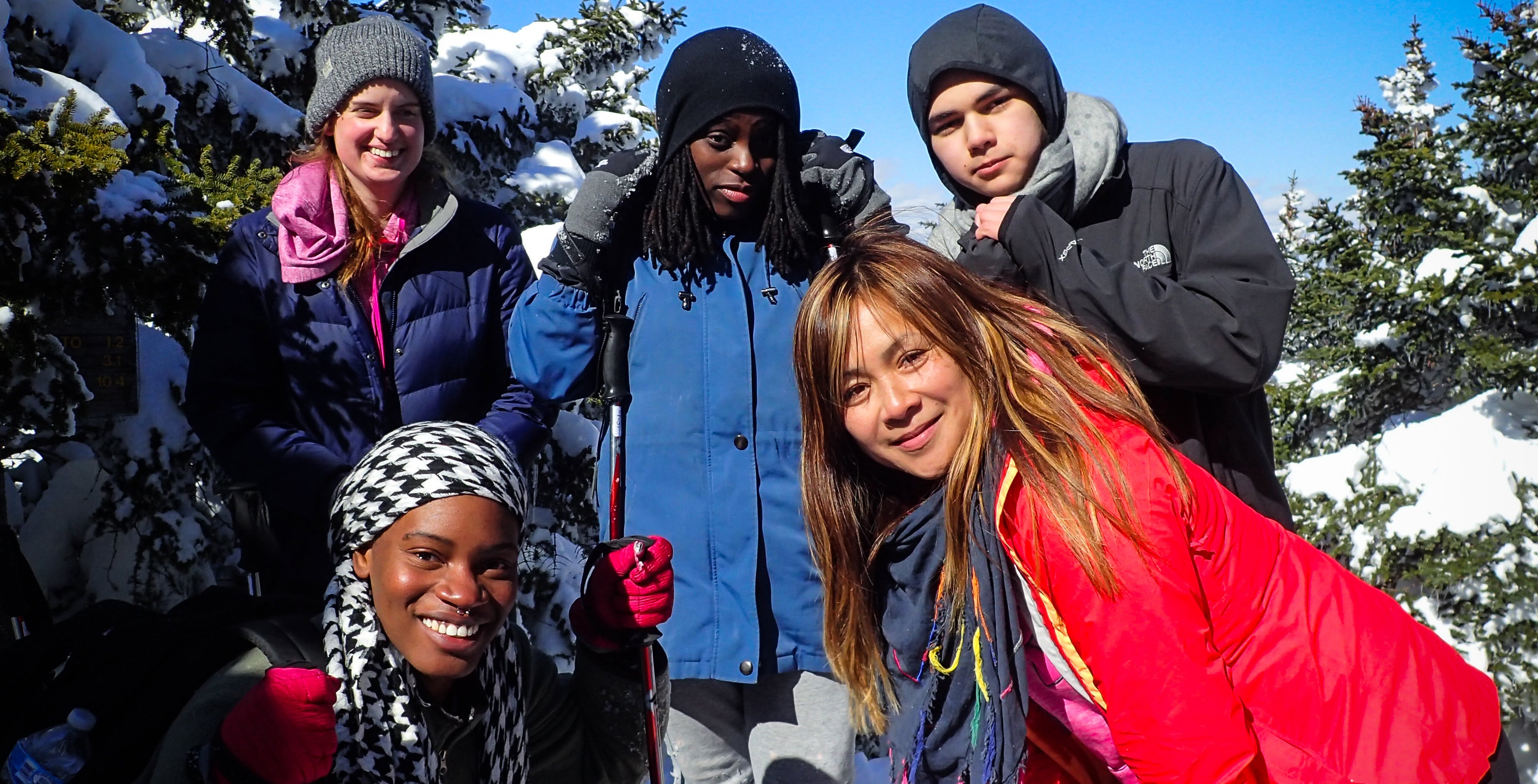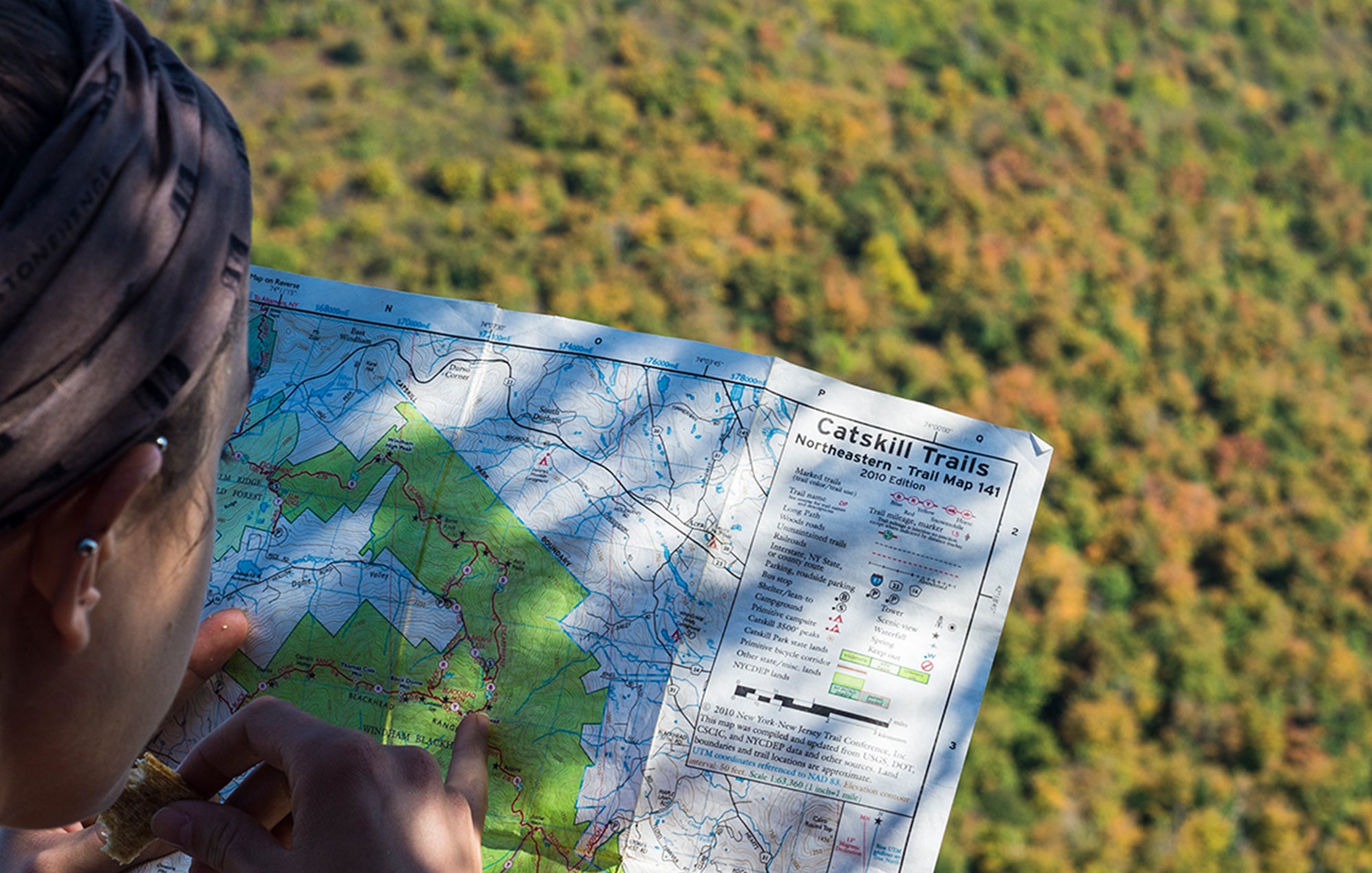Medical Considerations for Winter Hiking

By Brad Winer, Licensed Outdoor Guide, NOLS Wilderness First Responder and AHA Basic Life Support Provider (CPR/AED)
Prevention is the best care. Planning and preparation are the key to preventing cold weather injuries. In the winter, margins for error are tighter and a small issue can spiral into a serious medical emergency very quickly. Before hitting the trail in the winter (and all seasons) I ask myself a simple question, ‘Do I have the gear and skills necessary to survive an unexpected night out?’ In the wilderness, even if you are able to call for assistance, that help is hours away at best. Knowing what to do in an emergency is critical, knowing how to prevent one saves lives.
What follows is a very basic introduction to a few medical issues commonly associated with winter recreation. It cannot replace experience and professional training. I highly recommend that you and those you venture into the wilderness with pursue basic first aid training. The 2-day Wilderness First Aid courses offered by top-notch wilderness medicine organizations such as NOLS and SOLO are a fantastic place to start.
Another way to accelerate your learning is by hiring a guide and/or recreating with people who are experienced. Experience is not learned overnight—guides and mentors have years of experience. In gaining that experience they have probably made a few mistakes along the way. They have learned these hard lessons for you and can pass on their wisdom so that you don’t have to learn the hard way.
I also advocate ‘communing with the dead’—that sounds macabre but reading about people who have experienced medical emergencies and survival situations in the wilderness—and learning who lived, who died, and why—may help you avoid the same mistakes they made or may give you the knowledge to survive a similar situation.
Common Winter Medical Issues:
1. Dehydration
Myth: The body needs much less water in the winter than it does in the summer.
Fact: You need just as much or more hydration in the winter as you do in the summer.
What and Why? Many people are surprised that dehydration can be an issue in the winter. In the Catskills, winter air is much drier than the air we breathe in other seasons. In the winter we lose a lot of H2O just from breathing. Also, our bodies work harder in the winter to move and to keep us warm. Along with extra food/calories to keep us fueled up, we need more water to help digest/metabolize all those calories into energy. Water is also very important for good blood circulation which among other things, distributes heat to our body and extremities, which in turn plays a part in preventing other cold injuries like hypothermia and frostbite.
Prevention: Hydration starts 24-48 hours before your hike. Drink water before, during, and after your hike, even if you do not feel thirsty. If you are thirsty, you are already dehydrated. Remember: ‘A happy mountaineer always pees clear!’
Signs & Symptoms: Thirst, dark yellow/orange urine, fatigue.
Treatment: If you are dehydrated, drink! Drink liquids with flavoring (light sugar, electrolytes, etc. but not alcohol or caffeine) in addition to plain water.
Pro Tip 1: Invest in a high-quality thermos. There is nothing more pleasing/life-giving than some warm liquid (or soup!) on a cold day.
Pro Tip 2: Before you hit the trail, fill up your water bottles with very hot water and put them in insulating sleeves (or your spare pair of thick wool socks!). Then pack them deep in your pack, away from the elements. This helps keep them from freezing and you might even have some warm liquid later in the day.
2. Hypothermia
Myth: Hypothermia can only occur when temperatures are below freezing.
Fact: Hypothermia happens all year round. It is a common medical issue (and cause of death) in the wilderness.
Myth 2: Taking off all my clothes and getting into a sleeping bag with a hypothermic person will help them warm up.
Fact: There is very little scientific evidence to suggest there is any significant heat transfer using this technique. In reality it is not practical or effective, and tragically, on occasion, two frozen bodies have been found in a single sleeping bag. You and your able-bodied teammates are much more effective being free to perform tasks which will directly help your patient—boiling water/preparing hot food, gathering wood to start a fire, building a shelter, calling for help, etc.
What and Why? Hypothermia results from the lowering of the body’s core temperature. Just a small decrease in core temperature can affect mental (brain) and physical function. Shivering is one of the first signs of mild hypothermia. These involuntary muscle contractions are your body’s attempt to generate heat. Deteriorated speech (mumbling), difficulty performing fine motor tasks (picking things up, zipping up a jacket, etc.), apathy, and difficulty thinking clearly/confusion are also common in mild hypothermia. As core temperature further decreases, moderate hypothermia sets in. Symptoms become more pronounced: shivering is severe and uncontrollable, speech is unintelligible, motor function is extremely difficult or impossible, and mental ability is further impaired. With severe hypothermia, shivering stops, the muscles and body become rigid, mental function shuts down and falls into unconsciousness, pulse and breathing slow. Without intervention, shock and death sets in.
Prevention: What to wear, how to wear it, and when to make adjustments is a whole subject on its own. Basically, stay warm and stay dry! Wind, wet, and cold are the ingredients for hypothermia—they are your enemies. Protect yourself against wind and wet with good waterproof/windproof layers. Protect yourself from cold with a good clothing/layering system. Remember—getting wet from perspiration is just as bad or worse than getting wet from rain and snow. Once you are wet in the winter it is nearly impossible to dry out, so not getting wet in the first place is paramount in preventing hypothermia. Give your body the fuel it needs in the winter. Eat, eat, eat. Hydrate, hydrate, hydrate. Sometimes you really have to force yourself to stop and take the time to eat and drink in the winter. Be disciplined and just do it!
Signs & Symptoms:
- Mild: Shivering; diminished fine motor movement, speech, and mental function (confusion); apathy
- Moderate: Violent uncontrollable shivering; unintelligible speech; loss of motor function; further mental deterioration
- Severe: Shivering stops/muscle rigidity; mental stupor (unconscious); pulse and breathing slow significantly (to nearly undetectable); shock, death
Treatment: First, change the environment. Take shelter—get out of the elements that are contributing to the hypothermia. Remove wet clothing and replace it with dry layers. Drink warm liquids and eat to provide fuel to the body (fuel the shivering). Add insulation—get the patient into a sleeping bag or better yet put your patient in a hypothermia wrap. A hypothermia wrap is like a human burrito. Put the (dry) patient into a sleeping bag (multiple sleeping bags, if possible) and use a waterproof tarp or tent fly to wrap around it (like a tortilla!). Insulate the whole thing from the ground with sleeping pads. Then, add heat. Chemical heat packs can help, or if you have a stove, heat up water, pour it into water bottles, and have the patient hold one on their chest. Place additional bottles under the armpits. (Caution: be sure to insulate the bottles so that they do not burn the patient.) Falling into water or full submersion is extremely serious and an immediate life threat in the winter. You must act quickly and with purpose to dry and warm the patient.
Pro Tip: Set a timer to go off every 60-90 minutes. Eat and drink whether or not you feel hungry or thirsty. It takes time for your body to turn that food into usable energy, so eating early and often ensures you will have energy when you really need it, like at the end of a very long, hard, cold day!
3. Local Cold Injuries—Frostbite, Immersion Foot
Myth: Rubbing or massaging frozen skin is an effective way to warm and thaw it.
Fact: If tissue is frozen, rubbing it is one of the worst things you can do. In fact, it will damage underlying tissue and make the injury more severe. This is because when skin freezes, the ice crystals which form in the tissue are sharp. When moved/rubbed they will act to damage blood vessels and skin cells.
What and Why? Immersion foot (aka trench foot) can happen in all seasons. It occurs when our feet are chronically cold and/or wet. Feet can become painful and permanent soft-tissue and nerve damage is possible. In winter, we are also concerned about frostbite, the actual freezing of tissue. There are three types of frostbite (in order of severity): superficial (surface of skin freezes), partial thickness (tissues below surface freeze), and full thickness (deep/total tissue freezing). It is often not possible to determine the severity of frostbite until it is thawed. Frostbite injury ranges from temporary discomfort and blistering, to permanent soft-tissue, nerve damage, and loss of limbs. Frostbite is most common in extremities and exposed skin.
Prevention: Know the environment you will be adventuring in and check the weather conditions, then wear appropriate boots, clothing, and protective gear. If you begin to feel any pain or discomfort, especially numbness, in your extremities, take care of it immediately. Do not wait! Time of exposure increases the severity of cold injuries. In wet and cold conditions, make sure you have spare dry clothing, especially socks and gloves. Check your feet often. Tight boots, gloves, and clothing (including jewelry) can work to restrict blood circulation, increasing the possibility of cold injuries. If camping, always sleep with warm, dry feet.
Take care of your adventure buddies! Monitor their performance. Are they experiencing trouble or pain? Stop and address the issue. Exposed skin can be frozen in minutes—or in extreme conditions, seconds. Frequently check exposed skin for any discoloration. Stop and fix the issue. In more extreme conditions, use the buddy system to make sure all skin on the face, head, and neck are protected. Without a mirror it is difficult to be sure goggles, hat, balaclava, etc. are in the proper position. Caffeine, alcohol, and nicotine restrict circulation and should be avoided.
Signs and Symptoms:
- Skin is ‘pruned’ (immersion foot), discolored, waxy, pale, mottled
- Numbness and/or pain
- Cold and soft (unfrozen/partially frozen), cold and hard (frozen)
- Blisters (after thawing)
Treatment: Prevention by being prepared and proactive is always the best treatment.
- Unfrozen skin: Dry the injury and use skin-to-skin contact to warm the injury, for example, placing a foot on your adventure buddy’s belly.
- Frozen skin: Ideally, frostbite should be immediately thawed by fully immersing the injury in warm (99-102°F) water. In a wilderness context, this is of course very difficult. Use skin to skin contact to thaw/warm the frozen tissue. Never use radiant heat (i.e. fire) or rubbing/massaging. Once thawed, protect the injury and do not allow it to refreeze.
- Pain Management: Immersion foot and frostbite (after thawing) can be extremely painful. Anti-inflammatory drugs ie. Ibuprofen are recommended.
Pro Tip: Lip and skin balms help protect exposed tissue from wind and cold. They do not replace protective face coverings in more extreme weather, but should definitely be part of your winter face protection system.
Final thoughts: In a lot of ways, winter is the most challenging season in terms of our health and well-being. Hypothermia and frostbite, for example, in their mild forms may be managed and treated in the field, but if we are not proactive, they can quickly become life-threatening medical emergencies. What do we do if we are hours away from our warm car or camp, or days away from a trailhead, and pinned down in a blizzard? Who do we call for help? Does anyone even know we are out here? First and foremost, we must do everything we can to avoid ever getting into these situations. It cannot be emphasized enough—thoroughly plan, prepare, and get appropriate training before hitting the trail. Then, be vigilant and proactive to make sure a small issue never becomes a life and death struggle. Be safe out there!



